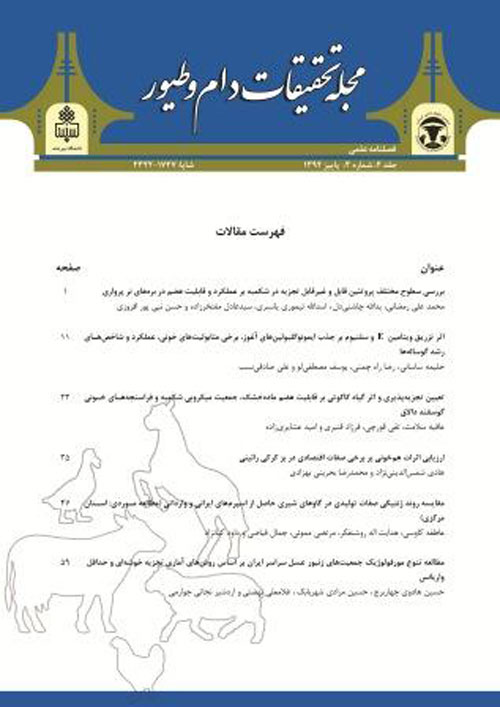Determination of the most optimum level of using different Lactobacillus strains and its effect on the amount of restaurant waste nutrients
Author(s):
Abstract:
The aim of this study was to determine the proportion of Lactobacillus strains liquid solution which was supposed to be added to the surface of restaurant waste (RW). To do so, each of different levels (2, 3, 5 and 7 ml) of liquid solution containing selected Lactobacillus strains (L. acidophilus, L. reuteri, L. plantarum and L. casei) was added to 1 kg of homogeneous and uniform waste with three replicates. The results of the first experiment indicated that adding 5 ml of liquid solution to 1 kg of the waste had the highest survival and economic justification. The second experiment evaluated the effect of 5 ml level of liquid solution on the amount of RW nutrients. Five treatments (four Lactobacillus treatments and one control treatment) were added to 1 kg of waste with five replicates. Finding of the experiment related to RW nutrients showed that microbial processing by Lactobacillus treatments caused a significant improvement as compared to the control treatment (P<0.05). Among the strains used L. acidophilus had the highest mean amount of crude protein (CP), ether extract (EE), dry matter (DM) and gross energy (GE) with respectively 21.40%, 19.91%, 41.02% and 4872.61 kcal/kg and it had the lowest amount of ash with 3.67% compared with the other strains. Due to fluctuations in the chemical composition of each meal and to resolve the ambiguity that whether the change in chemical composition of the waste is influenced by days and weeks or not, an individual experiment was conducted and the chemical composition of the meals was separately analyzed during 4 weeks. The results of the experiment demonstrated that there was not a close relationship between the weeks and the mean chemical compositions of the raw waste. Average CP, DM, EE, ash and GE for all days of the week were 18.74% 38.46% 18.67% 4.09% and 4497.65 kcal/kg, respectively. These results clearly showed that the numbers gained from sampling and the uniform mixtures of the waste were not significantly different. The amounts of CP, DM, EE, ash and GE within the uniform mixture were 18.87%, 38.78%, 18.84%, 4.12% and 4507.33 kcal/kg, respectively. The economic calculation of using RW showed that its use in poultry diet is permitted and it is more economical.
Keywords:
Language:
Persian
Published:
Journal of Livestock Research, Volume:2 Issue: 1, 2014
Page:
21
magiran.com/p1227660
دانلود و مطالعه متن این مقاله با یکی از روشهای زیر امکان پذیر است:
اشتراک شخصی
با عضویت و پرداخت آنلاین حق اشتراک یکساله به مبلغ 1,390,000ريال میتوانید 70 عنوان مطلب دانلود کنید!
اشتراک سازمانی
به کتابخانه دانشگاه یا محل کار خود پیشنهاد کنید تا اشتراک سازمانی این پایگاه را برای دسترسی نامحدود همه کاربران به متن مطالب تهیه نمایند!
توجه!
- حق عضویت دریافتی صرف حمایت از نشریات عضو و نگهداری، تکمیل و توسعه مگیران میشود.
- پرداخت حق اشتراک و دانلود مقالات اجازه بازنشر آن در سایر رسانههای چاپی و دیجیتال را به کاربر نمیدهد.
In order to view content subscription is required
Personal subscription
Subscribe magiran.com for 70 € euros via PayPal and download 70 articles during a year.
Organization subscription
Please contact us to subscribe your university or library for unlimited access!


